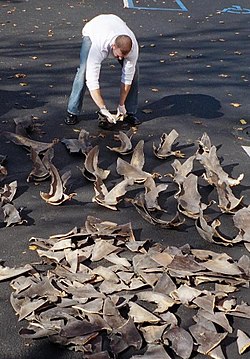This article needs to be updated. (January 2022) |


Shark finning is the act of removing fins from sharks and discarding the rest of the shark back into the ocean. This act is prohibited in many countries.[1] The sharks are often still alive when discarded, but without their fins.[2][3][4] Unable to swim effectively, they sink to the bottom of the ocean and die of suffocation or are eaten by other predators. Shark finning at sea enables fishing vessels to increase profitability and increase the number of sharks harvested, as they must only store and transport the fins, by far the most profitable part of the shark; the shark meat is bulky to transport.[5] Many countries have banned this practice and require the whole shark to be brought back to port before removing the fins.
Shark finning increased since 1997 largely due to the increasing demand for shark fins for shark fin soup and traditional cures, particularly in China and its territories, as a consequence of its economic growth, and as a result of improved fishing technology and market economics.[6] Shark fin soup substitutes have lately also appeared on the market which do not require any shark fins.[7][8]
The International Union for Conservation of Nature's Shark Specialist Group say that shark finning is widespread, and that "the rapidly expanding and largely unregulated shark fin trade represents one of the most serious threats to shark populations worldwide".[9] Estimates of the global value of the shark fin trade range from US$540 million[5] to US$1.2 billion (2007).[10] Shark fins are among the most expensive seafood products, commonly retailing at US$400 per kg.[9] In the United States, where finning is prohibited, some buyers regard the whale shark and the basking shark as trophy species, and pay $10,000 to $20,000 for a fin.[11]
The regulated global catch of sharks reported to the Food and Agriculture Organization of the United Nations has been stable in recent years at an annual average just over 500,000 tonnes. Additional unregulated and unreported catches are thought to be common.[12][13]
Shark finning has caused catastrophic harm to the marine ecosystem.[14] Roughly 73 to 100 million sharks are killed each year by finning.[14][15] A variety of shark species are threatened by shark finning, including the critically endangered scalloped hammerhead shark.[15]
- ^ Dell’Apa, Andrea; Chad Smith, M.; Kaneshiro-Pineiro, Mahealani Y. (1 August 2014). "The Influence of Culture on the International Management of Shark Finning". Environmental Management. 54 (2): 151–161. Bibcode:2014EnMan..54..151D. doi:10.1007/s00267-014-0291-1. ISSN 1432-1009. PMID 24828065. S2CID 30437872.
- ^ Schindler, D.E., Essington, T.E., Kitchell, J.F., Boggs, C. and Hilborn, R. (2002) "Sharks and tunas: fisheries impacts on predators with contrasting life histories". Ecological Applications, 12 (3): 735–748. doi:10.1890/1051-0761(2002)012[0735:SATFIO2.0.CO;2]
- ^ Spiegel, J. (2000) "Even Jaws deserves to keep his fins: outlawing shark finning throughout global waters". Boston College International and Comparative Law Review, 24 (2): 409–438.
- ^ Fowler, S., Séret, B. and Clarke, S. (2010) Shark fins in Europe: Implications for reforming the EU finning ban Archived 13 April 2017 at the Wayback Machine, IUCN Shark Specialist Group.
- ^ a b Clarke, Shelley; Milner-Gulland, E.J.; Bjorndal, Trond (October 2007). "Social, Economic, and Regulatory Drivers of the Shark Fin Trade". Marine Resource Economics. 22 (3): 305–327. doi:10.1086/mre.22.3.42629561. S2CID 151222229. Retrieved 3 April 2012.
- ^ Urbina, Ian (2016). "Palau vs. Poachers". The New York Times.
- ^ Wu, Leslie. "Faux Fins And Mock Meat: Is Clean Meat The Answer To Reforming Shark Fin And Foie Gras?". Forbes.
- ^ "Faux Fin". The Future Market.
- ^ a b Buckley, Louis (2007). The End of the Line (PDF). WildAid. p. 21. Archived from the original (PDF) on 2 December 2011.
- ^ Cite error: The named reference
York2003was invoked but never defined (see the help page). - ^ Bijal P. Trivedi (17 September 2002). "Shark-Soup Boom Spurs Conservationist DNA Study". National Geographic. Archived from the original on 18 September 2002. Retrieved 3 April 2012.
- ^ The State of World Fisheries and Aquaculture 2014 Page 17 and 124, FAO, Rome. ISBN 978-92-5-108275-1.
- ^ "Colombia seizes nearly 3,500 shark fins bound for Hong Kong". CNN. Reuters. 25 September 2021. Retrieved 25 September 2021.
- ^ a b Ker Than (26 September 2006). "Shark Slaughter: 73 Million Killed Each Year". Live Science. Retrieved 12 December 2019.
- ^ a b Caty Fairclough (August 2013). "Shark Finning: Sharks Turned Prey". Ocean.si.edu. Retrieved 12 December 2019.